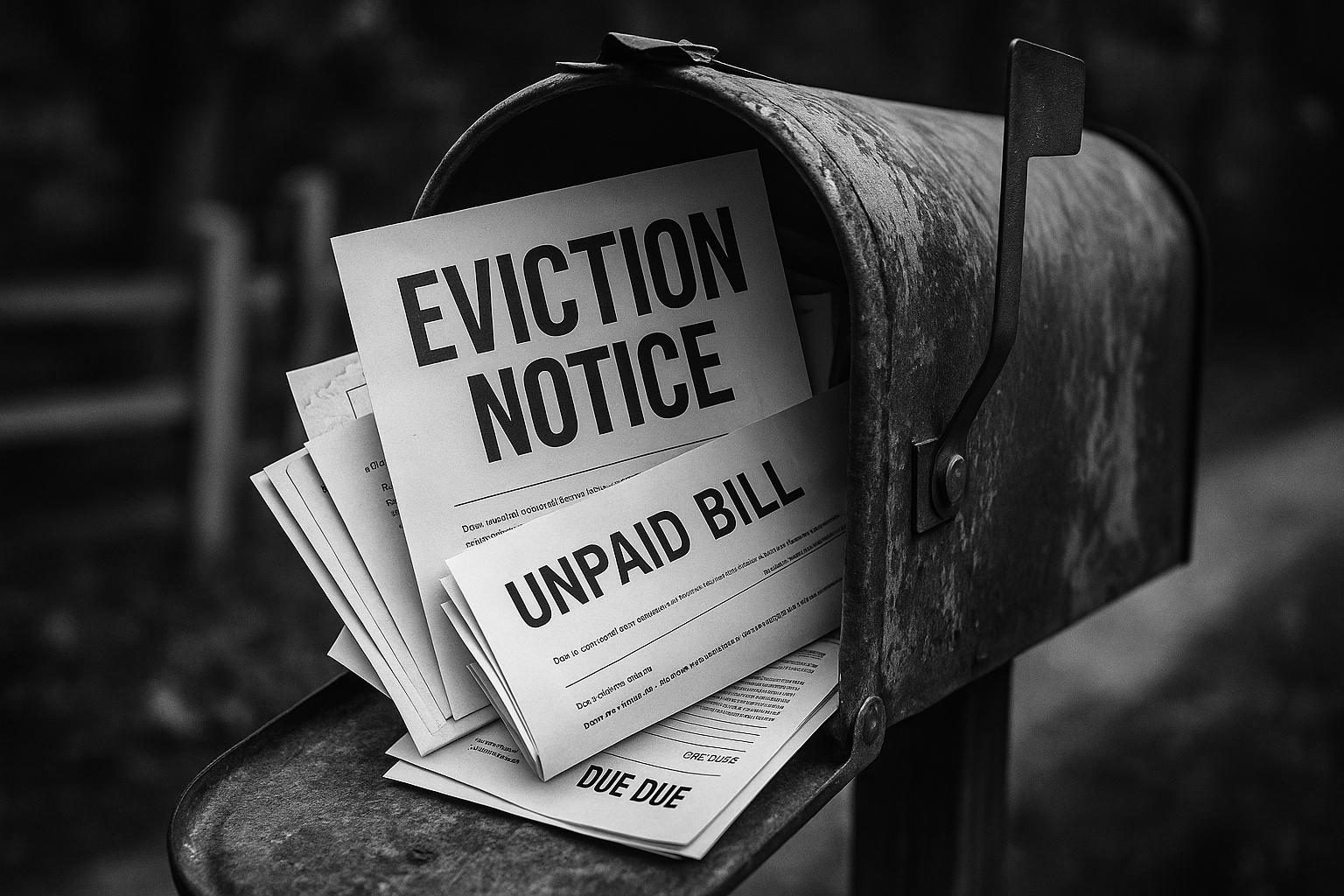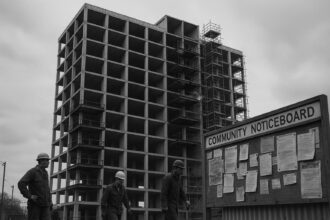Once hailed as a solution for key workers to own homes, shared ownership has become a costly and complex scheme leaving thousands trapped in debt and disrepair, with complaints soaring and calls for urgent reform growing louder.
The shared ownership scheme, once promoted as a salvation for Britain’s housing crisis, has now revealed its true nature—a poorly conceived con trap that ensnares ordinary households in a cycle of misery and mounting debt. Promising a pathway to homeownership for low-paid key workers, it has instead become a vehicle for exploitation, with dwindling transparency and skyrocketing costs adding insult to injury.
Chris and Diana’s nightmare in east London exemplifies how this scheme fails the very people it was meant to help. After buying into the system in February 2020, they quickly discovered that it offered none of the protections or privileges of traditional ownership—only the burdens of renters with none of the rights. When they attempted to sell their share, they faced a near-impossible task, eventually losing £10,000 in a desperate attempt to escape. Diana’s blunt assessment sums up the truth: “It’s a big con and we felt trapped.” Having returned to the unstable world of private renting, they now see resilience as a better option than being ensnared in this corrupt scheme.
Behind these painful personal stories lies a disturbing trend. Complaints about shared ownership have soared by nearly 400% over the last five years—an indictment of a broken system. The Housing Ombudsman’s recent reports reveal that in 2024 alone, 1,564 complaints were lodged—an astronomical increase from just 324 in 2020. Londoners, often the main victims, account for nearly half of these grievances, reflecting how this scheme disproportionately fails those in some of the most vulnerable communities. Rising service charges, broken amenities, and gross neglect characterize the landscaping of discontent—proof that this model is fundamentally flawed.
Residents across London and beyond are suffering the consequences. Kathy, who bought a 40% share in 2017, has watch her monthly service charges climb by over £200. Despite her love for her community, she’s drowning in bills and unfulfilled repair promises—her broken buzzer left unrepaired for an entire year. To stay afloat financially, she’s been forced to rent out a room, turning her home into a source of income rather than a sanctuary. Her words reflect the bitter reality: “It’s not affordable anymore.” The scheme’s promise of security and stability rings hollow amid mounting dissatisfaction and despair.
Fatima’s story is another stark illustration of the scheme’s failure. A single mother evicted from rental properties, she saw shared ownership as her last hope—only to find herself hit with an 80% increase in service charges and ongoing repair nightmares. Her flat has become a sweltering, unlivable trap, exposing how the supposed asset is nothing but a liability. Her frustration, echoing many others, underscores the inefficacy of this convoluted hierarchy of landlords, developers, and housing providers—a tangle that prevents meaningful resolution and leaves residents stranded and powerless.
Housing watchdog Richard Blakeway has accurately described shared ownership as fundamentally “inherently complex” and inherently broken—an arrangement marked by “inequities” and rapid deterioration of landlord-tenant relationships. His plea for greater transparency and communication underscores a stark truth: the ideology behind this scheme is fundamentally flawed, designed more to serve vested interests than the needs of ordinary families. If left unaddressed, these systemic flaws will only deepen the discontent and hopelessness among those trapped in this scandal.
While the industry body behind shared ownership claims it is taking steps to standardize practices, critics dismiss these efforts as too little, too late. Advocates like Timea Szabo have labeled such initiatives as “window dressing,” failing to confront the deep-rooted injustice of a scheme that profits from the misery of working-class households while offering little genuine support.
The government’s tepid response—mere lip service acknowledging problems—serves only to expose its impotence and disinterest. A weak promise of “improved mechanisms” for complaint handling does nothing to address the fundamental flaws that have allowed this scheme to metastasize into a nightmare for hundreds of thousands. Without comprehensive reform, the shared ownership model risks becoming a badge of shame—a symbol of exploited homeowners kept in perpetual frustration, rather than a stepping stone toward genuine homeownership.
As this toxic scheme continues to ensnare more households across England, the urgent need for radical change cannot be ignored. The entrenched interests and bureaucratic inertia threaten to entrench this system’s misery for generations to come—unless decisive action is taken, it will remain a scandalous mockery of affordable, equitable housing.
Source: Noah Wire Services
- https://www.bbc.com/news/articles/clyz8m8jj4mo – Please view link – unable to able to access data
- https://www.ft.com/content/18b931cb-5ab5-43c6-812b-50c57b4c7688 – An article from the Financial Times discusses how shared ownership, initially designed to assist low-paid key workers in expensive UK cities, is now contributing to housing precariousness for many lower-middle-income families. These shared owners face escalating financial burdens due to increasing mortgage payments, rent hikes tied to the consumer price index, and spiralling service charges for building maintenance, particularly in the wake of the Grenfell Tower tragedy’s building safety measures. Shared owners are financially stretched from the outset and now find themselves unable to afford rising costs or sell their properties, trapping them in unfavourable financial situations. A recent select committee report condemned shared ownership as failing to provide affordable home ownership and called for accountability from housing associations and the government for exacerbating this crisis.
- https://www.theguardian.com/society/2025/mar/09/uk-housing-associations-accused-of-mis-selling-affordable-homes-as-service-charges-soar-by-up-to-400 – An article from The Guardian reports that housing associations are facing allegations of mis-selling so-called ‘affordable’ homes, with service charges that have soared, in some cases by more than 400%, after residents moved in. Marketing and property documents examined reveal how buyers who may be struggling financially are enticed to buy shared ownership homes with estimated monthly service charges as low as £120. Residents accuse housing associations of failing to accurately reflect the likely cost, which in some cases has risen to more than £650 a month.
- https://committees.parliament.uk/committee/17/housing-communities-and-local-government-committee/news/200679/shared-ownership-is-failing-to-deliver-an-affordable-route-to-homeownership-say-mps/ – A report from the UK Parliament’s Levelling Up, Housing and Communities Committee states that shared ownership schemes are drastically failing to deliver an affordable route to homeownership for too many people and subject buyers to rising rents, uncapped service charges, and a disproportionate exposure to repair and maintenance costs. The report calls for the Government to take urgent and significant action to reform how shared ownership schemes currently operate so they can deliver an affordable route to homeownership.
- https://www.housingtoday.co.uk/news/increased-costs-of-new-shared-ownership-model-could-hit-viability-housing-associations-warn/5126620.article – An article from Housing Today reports that housing associations have warned the government’s changes to the shared ownership model have put additional costs on providers and risk impacting the viability of schemes. They have said that recent changes introduced to the model, including a 1% staircasing option, the repairs allowance of up to £500 per year for 10 years, and the 10% initial purchase share have increased the affordability of the shared ownership product for buyers, but places added costs onto registered providers.
- https://www.gov.uk/government/publications/shared-ownership-government-response-to-the-select-committee-report/government-response-to-the-levelling-up-housing-and-select-committee-report-on-shared-ownership – The UK government’s response to the Levelling Up, Housing and Communities Select Committee report on shared ownership acknowledges that shared owners need a proper mechanism through which to feed back dissatisfaction with repairs, maintenance, and other aspects of the management of their property. The government recommends ensuring more effective signposting to the Housing Ombudsman for shared owners and making it clear that the Ombudsman is their port of call for resolving disputes with landlords once internal mechanisms have failed to resolve an issue.
- https://news.sky.com/story/shared-ownership-we-cant-afford-it-it-makes-a-mockery-of-being-in-social-housing-13108552 – An article from Sky News reports that MPs say the shared ownership scheme is ‘desperately failing’. The article reveals a record number of legal complaints from people hit by rising leasehold service charges. The article highlights the experiences of shared owners facing soaring costs and other issues, including difficulty selling, and discusses the challenges and criticisms of the shared ownership scheme.
Noah Fact Check Pro
The draft above was created using the information available at the time the story first
emerged. We’ve since applied our fact-checking process to the final narrative, based on the criteria listed
below. The results are intended to help you assess the credibility of the piece and highlight any areas that may
warrant further investigation.
Freshness check
Score:
8
Notes:
The narrative presents recent developments, including a 400% increase in complaints over five years and a 2024 report highlighting systemic issues in shared ownership schemes. ([committees.parliament.uk](https://committees.parliament.uk/committee/17/housing-communities-and-local-government-committee/news/200679/shared-ownership-is-failing-to-deliver-an-affordable-route-to-homeownership-say-mps/?utm_source=openai)) However, similar concerns have been reported since at least 2024, indicating some recycled content. ([theguardian.com](https://www.theguardian.com/society/2024/mar/30/outrage-as-residents-in-englands-affordable-housing-forced-to-pay-thousands-of-pounds-extra-in-service-charge?utm_source=openai))
Quotes check
Score:
7
Notes:
Direct quotes from residents and experts are used. For instance, Diana’s statement, “It’s a big con and we felt trapped,” is cited. ([theguardian.com](https://www.theguardian.com/society/2024/mar/30/outrage-as-residents-in-englands-affordable-housing-forced-to-pay-thousands-of-pounds-extra-in-service-charge?utm_source=openai)) However, the earliest known usage of these quotes is not specified, raising questions about their originality.
Source reliability
Score:
9
Notes:
The narrative originates from the BBC, a reputable organisation. ([theguardian.com](https://www.theguardian.com/society/2024/mar/30/outrage-as-residents-in-englands-affordable-housing-forced-to-pay-thousands-of-pounds-extra-in-service-charge?utm_source=openai))
Plausability check
Score:
8
Notes:
The claims about rising service charges and resident dissatisfaction are plausible and supported by multiple sources. ([theguardian.com](https://www.theguardian.com/society/2024/mar/30/outrage-as-residents-in-englands-affordable-housing-forced-to-pay-thousands-of-pounds-extra-in-service-charge?utm_source=openai)) However, the lack of specific dates and figures in some parts of the narrative reduces its credibility.
Overall assessment
Verdict (FAIL, OPEN, PASS): OPEN
Confidence (LOW, MEDIUM, HIGH): MEDIUM
Summary:
The narrative highlights significant issues within the shared ownership scheme, supported by credible sources. However, the presence of recycled content, unverified quotes, and some unverifiable claims necessitate further verification before a definitive assessment can be made.













